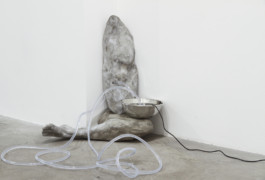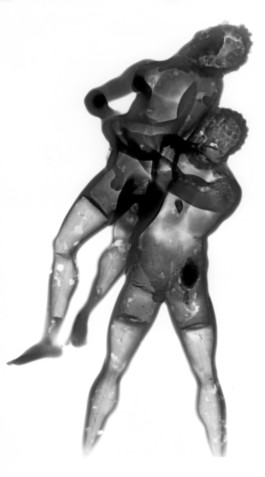Alix Marie
La Femme Fontaine
& Maija Tammi
White Rabbit Fever
14.01.2017 –
25.02.2017

Matèria is pleased to present La Femme Fontaine, the first exhibition in Italy by the French artist Alix Marie (Paris,1989) and the first Italian showcase of White Rabbit Fever, a body of work by Finnish artist Maija Tammi (Helsinki, 1985).
Maija Tammi’s White Rabbit Fever is a body of work centered on the ephemeral balance between life and death. Through a careful selection of works extracted from the series, the exhibition showcases the diverse aspects of Tammi’s research, ranging from the inception and origin of life exemplified in nature, to the scientific and philosophical realms via the use of of still life photography, laboratory documentation and installation based work.
Tammi’s fascination with the topic stems from the multitude of typologies and significations associated with death: from the clinical definition to a biological one, to viable stem cells still alive in a 17 days old corpse. The cornerstone the research initiated by Maija Tammi resides in American woman Henrietta Lacks, who died in 1951 and whose cells are kept alive and continuously grown decade after decade in laboratories worldwide. Her cells – named HeLa cells – have been grown extensively and even sent into space.
The complete series of laboratory experimentation draws from Lacks’ HeLa cells, Pa-Ju cells derived from a teenage patient who died in 1983, and Us-Ki cells from another patient in 2009, all of which Tammi has been growing and documenting under controlled conditions at a laboratory in Helsinki, Finland.
The title White Rabbit Fever – a fictional disease coined by Tammi – is utilised as the archetype for illnesses, a violation of the concept of time, that when aligned with Lack’s post mortem laboratory life, creates the paradox between infinite life and a inescapable death.
Tammi confronts the uncomfortable, juxtaposing the beauty of nature and the mystery of our existence, to the universal concept of death that binds us all; an inescapable shared fate we shy away from in the hope of obtaining infinite life.
Trough her practice Alix Marie investigates the correspondences between the medium of photography, known as ‘casting with light’ and the sculptural practice of casting bodies, alternating a crude exploration of flesh with a delicate survey of the notion of body. The photographic medium, which is analysed both aesthetically and theoretically is here challenged and stretched by becoming part of a three dimensional experience were the viewer is caught in-between familiar and unfamiliar, logic and irrational, uncanny and domestic.
La Femme Fontaine presents a new body of work, site specific, that is composed by a series of x-rays of antique sculptures and an enchanting water installation made of concrete casts.
Responding to the city of Rome, Marie has chosen to create a fountain which both references the discovery of waterproof concrete during the Roman Empire whilst incorporating fragments of the body which come from a long time enthralment for Antique and Classical sculpture.
This new body of work encompasses many of Marie’s key elements of her practice: the clinical aspect of photography combined with a fascination of the connections between art and medicine, mythology and autobiography, and the feminine symbolic.
La Femme Fontaine (in French a double-entendre as it also means squirting) is an installation of concrete casts of the artist’s body. Marie confronts herself as she subtly evokes the Pygmalion’s myth by embracing and attempting at the same time to be the artist, the muse and the sculpture: an aching yet empowering symbol of the contemporary female.
Alix Marie’s practice mixes the autobiographic with medium-specific interests. The installation La Femme Fontaine references the myth of Niobe in which a woman is turned into an eternally crying stone sculpture, for Alix Marie this myth embodies perfectly her recent heartbreak.
The work is fed by Marie’s on-going concerns around the role of women in society today, especially the research around the notion of fluid, and how they are historically linked to the symbolic of the feminine and the abject while in contemporary culture pictures of menstruations are censored from social medias like Instagram or the depiction of female ejaculation banned from pornography in the UK.
Combining the tender and the raw La Femme Fontaine is a journey through the depths and layers of a contemporary portrayal of the female: unnerving yet domestic, cruel yet inviting, that mocks hysteria by presenting itself in commanding concrete whilst subtly subverting the gaze from universal to particular.





